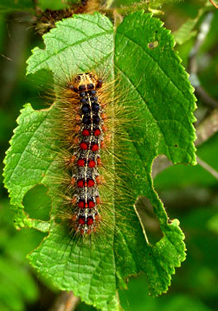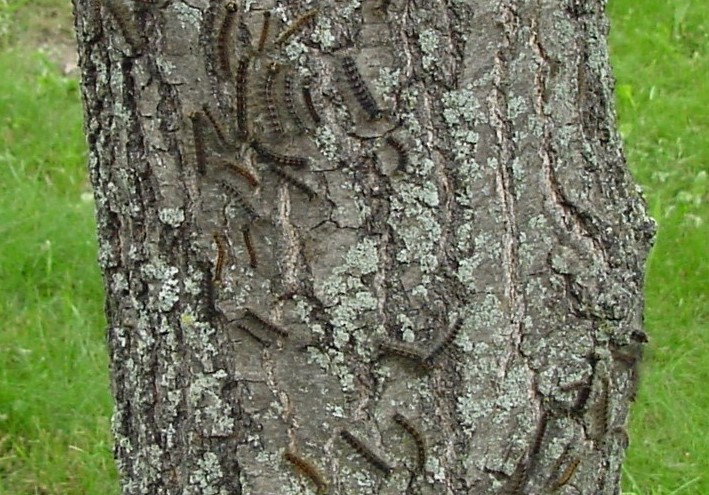Spongy Moth
The European spongy moth (Lymantria dispar) was introduced into Massachusetts in 1869. Since then, spongy moths have defoliated millions of acres of trees in forests and urban areas in at least 20 states and the Washington, D.C., area. Spongy moth caterpillars feed on more than 300 species of deciduous and evergreen trees.
Spongy moth populations may have a temporary, large increase (an “outbreak”) in an area about every 10-12 years, lasting 2-3 years. Defoliation of susceptible tree and shrub species may be widespread during outbreaks, although healthy trees and shrubs are likely to survive if they are defoliated. High caterpillar numbers can be a tremendous nuisance. In addition, the caterpillar hairs can cause skin rashes and other reactions in some people.
Management options for reducing high populations include: egg mass oils, barrier and collection bands, physically destroying life stages, drowning egg masses and caterpillars in a can of soapy water, insecticidal soaps and insecticide application to high-value trees or forest stands. The DNR has produced a guide to insecticide options for homeowners.
Spongy moths were first found in Wisconsin in the late 1960s in the eastern part of the state. Infestations were found in the Milwaukee area in the early 1990s. Moths have since been found in every county. The eastern two-thirds of the state is considered generally infested and is quarantined. The quarantine prohibits the movement of items that could harbor spongy moth eggs, caterpillars or adults and allow them to be moved to uninfested areas. For information on what items are regulated and how to comply with the law, go to the Wisconsin spongy moth quarantine page.
People living in non-quarantined counties may come across spongy moth. If you do, call 1-800-642-MOTH (6684) or email spongymoth@wisconsin.gov to report it and please take these reasonable precautions to reduce the spread of spongy moth.
The effort to slow the establishment of spongy moth continues in unquarantined counties of western Wisconsin. In these counties, the Wisconsin Department of Agriculture, Trade and Consumer Protection (DATCP) monitors for the pest using traps and conducts aerial spray treatments on any isolated populations it finds. Find more information on DATCP's spongy moth aerial spray program page.
More information is available on the DNR’s spongy moth fact sheet [PDF]. For help understanding how to tell if a caterpillar is a spongy moth caterpillar or a look-alike species, reference the Caterpillar Comparison (Common Spring Defoliators) fact sheet.


